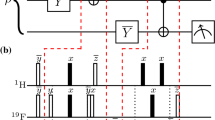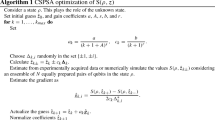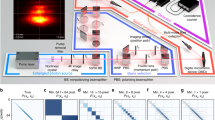Abstract
Quantum superposition is a fundamental principle of quantum mechanics, so it is not surprising that equal superposition states (ESS) serve as powerful resources for quantum information processing. In this work, we propose a quantum circuit that creates an arbitrary dimensional ESS. The circuit construction is efficient as the number of required elementary gates scales polynomially with the number of required qubits. For experimental realization of the method, we use techniques of nuclear magnetic resonance (NMR).We have succeeded in preparing a 9-dimensional ESS on a 4-qubit NMR quantum register. The full tomography indicates that the fidelity of our prepared state with respect to the ideal 9-dimensional ESS is over 96%. We also prove the prepared state is pseudo-entangled by directly measuring an entanglement witness operator. Our result can be useful for the implementation of those quantum algorithms that require an ESS as an input state.
Similar content being viewed by others
References
L. K. Grover, Science 280, 228 (1998).
M. A. Nielsen, and I. L. Chuang, Quantum Computation and Quantum Information (Cambridge University Press, Cambridge, 2010).
P. W. Shor, in Algorithms for quantum computation: Discrete logarithms and factoring: Proceedings of the 35th Annual Symposium on Foundations of Computer Science, edited by S. Goldwasser (IEEE, New York, 1994), pp. 124–134.
I. Chuang, R. Laflamme, P. Shor, and W. Zurek, arXiv: quantph/9503007.
L. M. K. Vandersypen, M. Steffen, G. Breyta, C. S. Yannoni, M. H. Sherwood, and I. L. Chuang, Nature 414, 883 (2001).
J. Li, X. Peng, J. Du, and D. Suter, Sci. Rep. 2, 260 (2012).
L. Hales and S. Hallgren, in An improved quantum Fourier transform algorithm and applications: Proceedings of the 41st Annual Symposium on Foundations of Computer Science (IEEE, Los Alamitos, 2000), pp. 515–525.
D. Coppersmith, arXiv: quant-ph/0201067.
M. Mosca, and C. Zalka, Int. J. Quantum Inform. 2, 91 (2004).
A. M. Childs, and W. van Dam, Rev. Mod. Phys. 82, 1 (2010).
A. Y. Kitaev, arXiv: quant-ph/9511026.
L. K. Grover, in A fast quantum mechanical algorithm for database search: Proceedings of the 28th annual ACM symposium on Theory of computing (ACM, 1996), pp. 212–219.
L. K. Grover, Phys. Rev. Lett. 79, 325 (1997).
L. K. Grover, Phys. Rev. Lett. 85, 1334 (2000).
R. M. Gingrich, C. P. Williams, and N. J. Cerf, Phys. Rev. A 61, 052313 (2000).
G. L. Long, and Y. Sun, Phys. Rev. A 64, 014303 (2001).
Y. Liu, and G. L. Long, Int. J. Quantum Inform. 07, 567 (2009).
Y. Long, G. R. Feng, J. Pearson, and G. L. Long, Sci. China-Phys. Mech. Astron. 57, 1256 (2014).
M. Gao, F. C. Lei, C. G. Du, and G. L. Long, Sci. China-Phys. Mech. Astron. 59, 610301 (2016).
R. Heilmann, M. Gräfe, S. Nolte, and A. Szameit, Sci. Bull. 60, 96 (2015).
Q. Lin, Sci. China-Phys. Mech. Astron. 58, 044201 (2015).
R. Horodecki, P. Horodecki, M. Horodecki, and K. Horodecki, Rev. Mod. Phys. 81, 865 (2009).
O. Ghne, and G. Tth, Phys. Rep. 474, 1 (2009).
T. Li, and Z. Q. Yin, Sci. Bull. 61, 163 (2016).
J. M. Cai, Sci. China-Phys. Mech. Astron. 60, 030331 (2017).
T. T. Li, Sci. China Math. 59, 1 (2016).
A. Barenco, C. H. Bennett, R. Cleve, D. P. DiVincenzo, N. Margolus, P. Shor, T. Sleator, J. A. Smolin, and H. Weinfurter, Phys. Rev. A 52, 3457 (1995).
M. Bourennane, M. Eibl, C. Kurtsiefer, S. Gaertner, H. Weinfurter, O. Gühne, P. Hyllus, D. Bruß, M. Lewenstein, and A. Sanpera, Phys. Rev. Lett. 92, 087902 (2004).
J. G. Filgueiras, T. O. Maciel, R. E. Auccaise, R. O. Vianna, R. S. Sarthour, and I. S. Oliveira, Quantum Inf. Process 11, 1883 (2012).
L. M. K. Vandersypen, and I. L. Chuang, Rev. Mod. Phys. 76, 1037 (2005).
M. H. Levitt, Spin Dynamics: Basics of Nuclear Magnetic Resonance (John Wiley & Sons, Chichester, 2001).
X. Peng, X. Zhu, X. Fang, M. Feng, K. Gao, X. Yang, and M. Liu, Chem. Phys. Lett. 340, 509 (2001).
J. S. Lee, Phys. Lett. A 305, 349 (2002).
J. Pan, Y. Cao, X. Yao, Z. Li, C. Ju, H. Chen, X. Peng, S. Kais, and J. Du, Phys. Rev. A 89, 022313 (2014).
J. A. Smolin, J. M. Gambetta, and G. Smith, Phys. Rev. Lett. 108, 070502 (2012).
C. A. Ryan, C. Negrevergne, M. Laforest, E. Knill, and R. Laflamme, Phys. Rev. A 78, 012328 (2008).
N. Khaneja, T. Reiss, C. Kehlet, T. Schulte-Herbrggen, and S. J. Glaser, J. Magn. Resonance 172, 296 (2005).
S. Kirkpatrick, C. D. Gelatt, and M. P. Vecchi, Science 220, 671 (1983).
Acknowledgments
This work was supported by the National Key Basic Research Program of China (Grant Nos. 2013CB921800, and 2014CB848700), the National Natural Science Foundation of China (Grant Nos. 11425523, 11375167, 11575173, and 11227901), the Strategic Priority Research Program (B) of the Chinese Academy of Sciences (Grant No. XDB01030400), and the Key Research Program of Frontier Sciences of the Chinese Academy of Sciences (Grant No. QYZDY-SSW-SLH004). The authors also thank ShenSen Zhao and LiHao Yang from University of Science and Technology of China for Python programming and discussion.
Author information
Authors and Affiliations
Corresponding authors
Rights and permissions
About this article
Cite this article
Yu, Q., Zhang, Y., Li, J. et al. Generic preparation and entanglement detection of equal superposition states. Sci. China Phys. Mech. Astron. 60, 070313 (2017). https://doi.org/10.1007/s11433-017-9040-3
Received:
Accepted:
Published:
DOI: https://doi.org/10.1007/s11433-017-9040-3




